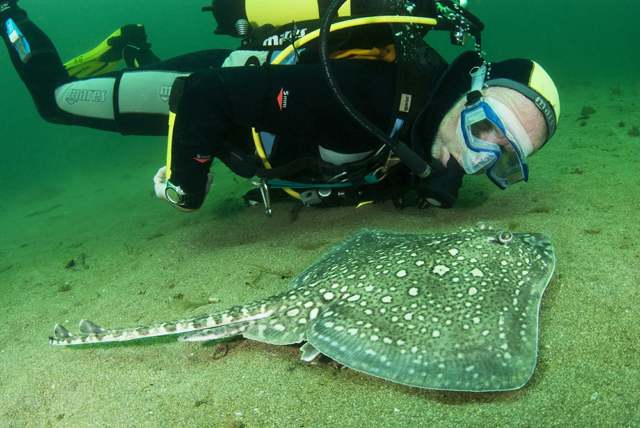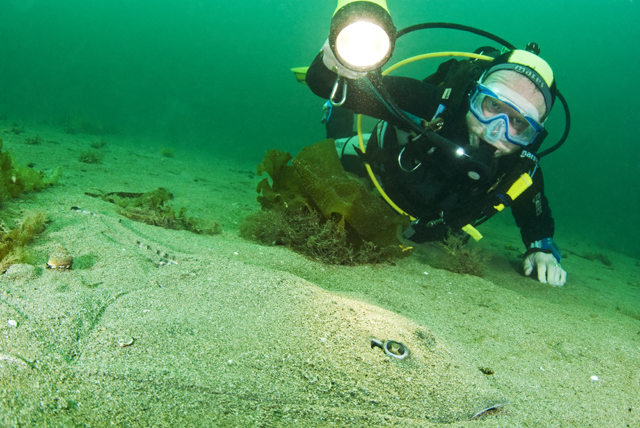News
Have a Ray Day
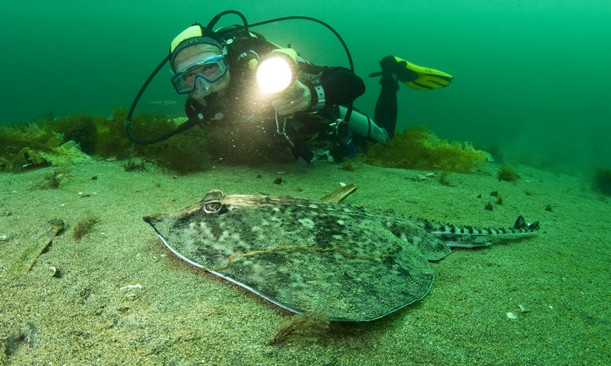
Mike Anselmi, the owner of Porthkerris Dive Centre in Cornwall, said that the Helford River Estuary is one of the most popular dive sites in the area. The shallow seabed attracts all sorts of interesting marine life including Sea Hares, Cuttlefish, Clams, Scallops, Hermits and Blonde Rays. May through to August is peak season for Thornback Ray (Raja clavata) sightings. Mike said that the Rays congregated in larger numbers around mid-August. During this time it’s not unusual to see at least 5 or 6 different individuals on a single 1 hour long dive. The Rays stick together in loose packs, so when one is sighted there are usually others somewhere close by.
This is a unique underwater experience and gives divers and photographers the perfect opportunity to get up close and personal with these creatures. It’s even possible to swim side by side as they effortlessly ‘fly’ across the seabed. Thornbacks shouldn’t be confused with their close relatives, Sting Rays. They are totally non-aggressive and pose no threat to divers. There are no lethal looking barbs protruding from the tail. Instead they have 30-50 spines along the tail and up the back which could potentially give someone a graze but only if the Ray is grabbed or picked up. The mouth is located on the white coloured underside. This has rows of very small teeth which make perfect tools for crunching on Crabs, Prawns and Flatfish – not divers.
The Charter Boat
Mike has been running the family business for more than 22 years. He owns 2 hard boats and a twin engined RIB. We went out on Mike’s flagship, the 14 metre long Celtic Cat. Getting onto the boat is quite a novel experience. There is no jetty, so divers have to walk along a high rise gangplank which is then pushed into the sea by a Tractor. Mike’s other hard boat, the smaller 8 metre long Celtic Kitten, has a bow ramp so it can come right up to the beach. Celtic Cat has plenty of room onboard for kitting up and gear stowage. The boat also has a big enclosed cabin area and an inner sanctum where I could get hot drinks. Mike has fitted a double diver lift on the stern which is controlled by CCTV linked to the high rise Bridge. Mike normally offers the Thornback Ray dive as and when he’s asked. He said that the Rays come closer inshore during calm weather; they don’t like choppy seas.
Arrival at the site
Porthkerris Dive Centre is located way down on the South West Coast of Cornwall near the Lizard. RNAS Culdrose is a good landmark to aim for and then follow the signs to St Keverne. The last few miles can be quite confusing (I took the wrong turning, duh!) but there’s still a mobile signal for any ‘help, I’m lost’ SOS calls to the dive centre. When I started seeing the Basking Shark (this is the other big attraction) signs I knew I was on the right track. The narrow hedge-lined lanes eventually open out onto a very picturesque little bay. The new dive centre building is located right next to the pebble beach. On-site facilities include a dive shop, 2 camp sites, toilets, cafe, car park, gas fills and plenty of shore diving possibilities. There are even a number of Pubs close by. The local Seal sanctuary located at Gweek is also worth a visit during off gassing periods.
Pre-dive briefing
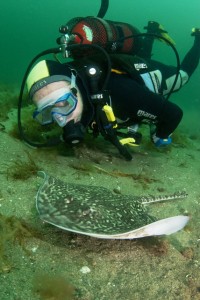
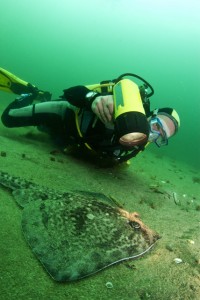 The Helford River is about 20 minute’s boat ride from Porthkerris Dive Centre. At high water it’s around 12 metres deep at the river mouth and 8 metres further up the estuary by the boat moorings. The seabed is made up of sand and shingle in the central channel. Nearer the edges and further up the estuary this changes to a maerl-like composition interspersed with patches of weed (perfect for Scallops).
The Helford River is about 20 minute’s boat ride from Porthkerris Dive Centre. At high water it’s around 12 metres deep at the river mouth and 8 metres further up the estuary by the boat moorings. The seabed is made up of sand and shingle in the central channel. Nearer the edges and further up the estuary this changes to a maerl-like composition interspersed with patches of weed (perfect for Scallops).
There can be strong currents, so it’s best to dive a few hours before high water on the flood tide when things are calming down. The visibility will be better and there is more chance of seeing Thornback Rays. Keep a close eye on air supplies, as chasing after Rays can be quite a tank-draining exercise. All divers should carry a delayed SMB. Mike asks that they are deployed at the end of the dive before commencing any safety stops. This is a busy waterway so be extra vigilant on ascents. Propeller haircuts are not advisable.
Mike dropped us in the middle of the channel right by the River mouth. The tide was still flooding which meant that the current would take us inside the channel rather than out to sea. We would also have ‘cleaner’ water for my photographs. We made a free descent without reference to the seabed. The Rays are not in any particular area so there is no set direction to take, it’s basically pot luck. We drifted along with the current scanning the seabed for any Ray like shapes.
The Dive
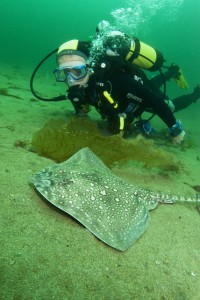 Creeping up on Thornback Rays turned out to be easier than I expected. I had brought along Brian Hayes, a diving friend of many years, to act as ‘model’ and Ray spotter. We found our first Ray in the first 2-3 minutes of our dive. I could make out the diamond shaped outline hidden under the sand. A pair of eye stalks and a sharp pointy nose were the only parts visible. I guess this was in readiness to strike at any prey that unwittingly wandered into the kill zone.
Creeping up on Thornback Rays turned out to be easier than I expected. I had brought along Brian Hayes, a diving friend of many years, to act as ‘model’ and Ray spotter. We found our first Ray in the first 2-3 minutes of our dive. I could make out the diamond shaped outline hidden under the sand. A pair of eye stalks and a sharp pointy nose were the only parts visible. I guess this was in readiness to strike at any prey that unwittingly wandered into the kill zone.
Working as a team we managed to get within touching distance of around 5 or 6 different Rays on each dive. The Rays seemed to react differently depending on the tide conditions. While the tide was still flooding they were more active and on the move. Mike thinks this is when they are feeding. On 3 occasions we had to swim like lunatics just to keep up. When there was very little tide we found 2 or 3 different Rays buried in the sand and they were very easy to approach – in fact, I could have touched them with my camera dome and they still wouldn’t have budged. I even got Brian to do a ‘Steve Irwin’ manoeuvre over the top of a Ray for a close-up head shot and there was still no reaction. Maybe the Ray thought that its camouflage was so good we couldn’t see it.
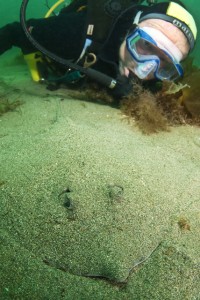 As the tide turned there seemed to be less Rays about and they were moving much more slowly. We had also moved up the estuary nearer to the boat moorings. The seabed composition had changed and there were far more Sea Hares around. We swam along with one particular Ray for a good 5 minutes and then bumped into a very photogenic Cuttlefish. None of the Rays shot off in an erratic manner or seemed distressed by our presence. Considering they were being sandwiched by 2 divers this was quite surprising.
As the tide turned there seemed to be less Rays about and they were moving much more slowly. We had also moved up the estuary nearer to the boat moorings. The seabed composition had changed and there were far more Sea Hares around. We swam along with one particular Ray for a good 5 minutes and then bumped into a very photogenic Cuttlefish. None of the Rays shot off in an erratic manner or seemed distressed by our presence. Considering they were being sandwiched by 2 divers this was quite surprising.
The Thornbacks we encountered varied in size from small 20cm wingspans to much bigger 50cm plus specimens. The colour schemes were usually grey or brown with a kaleidoscope pattern of spots and splodges on the topside. Most had 2 claspers dangling from the tail area meaning they were males. We only encountered one small female. Average recorded sizes are around 60 cm and weigh in at 3 or 4kg’s. They can grow to more than a metre in length and weigh over 15kg’s.
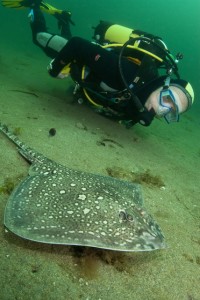 This has to be one of the best marine life dives in the UK and it’s at a shallow depth where every level of diver can safely join in the fun. Our close encounters were totally natural. There was no provocation or feeding enticements going on in the background. They say a picture paints a thousand words so hopefully my photographs show just how close we managed to get. With rather more luck than judgement we had chosen a perfect day for weather. There was plenty of sunlight and very little wave action to worry about. Underwater visibility was around 8 metres throughout and the current took away any kicked up silt during our power finning spurts. For once I actually had to admit this was pretty good going for UK conditions. The toughest part of the day was keeping my model focused on the job in-hand. Brian was getting more and more distracted by the number of decent sized Scallops scattered over the seabed. He even had his goody bag at the ready!
This has to be one of the best marine life dives in the UK and it’s at a shallow depth where every level of diver can safely join in the fun. Our close encounters were totally natural. There was no provocation or feeding enticements going on in the background. They say a picture paints a thousand words so hopefully my photographs show just how close we managed to get. With rather more luck than judgement we had chosen a perfect day for weather. There was plenty of sunlight and very little wave action to worry about. Underwater visibility was around 8 metres throughout and the current took away any kicked up silt during our power finning spurts. For once I actually had to admit this was pretty good going for UK conditions. The toughest part of the day was keeping my model focused on the job in-hand. Brian was getting more and more distracted by the number of decent sized Scallops scattered over the seabed. He even had his goody bag at the ready!
Blogs
Northern Red Sea Reefs and Wrecks Trip Report, Part 3: The Mighty Thistlegorm

Jake Davies boards Ghazala Explorer for an unforgettable Red Sea diving experience…
Overnight, the wind picked up, making the planned morning dive a bit bumpy on the Zodiacs to the drop point on Thomas Reef. There, we would dive along the reef before descending through the canyon and then passing under the arch before ascending the wall with a gentle drift. The site provided great encounters with more pelagic species, including shoals of large barracuda, tuna, and bigeye trevally.
Once back on the boat, it was time to get everything tied down again as we would head back south. This time, with the wind behind us, heading to Ras Mohammed to dive Jackfish Alley for another great gentle drift wall dive before then heading up the coast towards the Gulf of Suez to moor up at the wreck of the Thistlegorm. This being the highlight wreck dive of the trip and for many onboard, including myself, it was the first time diving this iconic wreck. I had heard so much about the wreck from friends, and globally, this is a must on any diver’s list. Fortunately for us, there was only one other boat at the site, which was a rarity. A great briefing was delivered by Ahmed, who provided a detailed background about the wreck’s history along with all the required safety information as the currents and visibility at the site can be variable.

Kitting up, there was a lot of excitement on deck before entering the water and heading down the shoreline. Descending to the wreck, there was a light northerly current which reduced the visibility, making it feel more like the conditions that can be found off the Welsh coast. At 10m from the bottom, the outline of the wreck appeared as we reached the area of the wreck which had been bombed, as our mooring line was attached to part of the propeller shaft. Arriving on deck, instantly everywhere you looked there were many of the supplies which the ship was carrying, including Bren Carrier tanks and projectiles that instantly stood out.

We headed around the exterior, taking a look at the large propeller and guns mounted on deck before entering the wreck on the port side to take a look in the holds. It was incredible to see all the trucks, Norton 16H, and BSA motorcycles still perfectly stacked within, providing a real snapshot in time.

Overall, we had four dives on the Thistlegorm, where for all of the dives we were the only group in the water, and at times, there were just three of us on the whole wreck, which made it even more special, especially knowing that most days the wreck has hundreds of divers. Along with the history of the wreck, there was plenty of marine life on the wreck and around, from big green turtles to batfish, along with shoals of mackerel being hunted by trevally. Some unforgettable dives.

The final leg of the trip saw us cross back over the Suez Canal to the Gobal Islands where we planned to stay the night and do three dives at the Dolphin House for the potential of sharing the dive with dolphins. The site, which included a channel that was teeming with reef fish, especially large numbers of goatfish that swam in large shoals along the edge of the reef. These were nice relaxing dives to end the week. Unfortunately, the dolphins didn’t show up, which was okay as like all marine life they are difficult to predict and you can’t guarantee what’s going to be seen. With the last dive complete, we headed back to port for the final night where it was time to clean all the kit and pack before the departure flight the next day.

The whole week from start to finish on Ghazala Explorer was amazing; the boat had all the facilities you need for a comfortable week aboard. The crew were always there to help throughout the day and the chefs providing top quality food which was required after every dive. The itinerary providing some of the best diving with a nice mixture of wreck and reef dives. I would recommend the trip to anyone, whether it’s your first Red Sea liveaboard in the Red Sea or you’re revisiting. Hopefully, it’s not too long before I head back to explore more of the Red Sea onboard Ghazala Explorer.

To find out more about the Northern Red Sea reef and wrecks itineraries aboard Ghazala Explorer, or to book, contact Scuba Travel now:
Email: dive@scubatravel.com
Tel: +44 (0)1483 411590
Photos: Jake Davies / Avalon.Red
Blogs
Northern Red Sea Reefs and Wrecks Trip Report, Part 2: Wall to Wall Wrecks

Jake Davies boards Ghazala Explorer for an unforgettable Red Sea diving experience…
The second day’s diving was a day full of wreck diving at Abu Nuhas, which included the Chrisoula K, Carnatic, and Ghiannis D. The first dive of the day was onto the Chrisoula K, also known as the wreck of tiles. The 98m vessel remains largely intact where she was loaded with tiles which can be seen throughout the hold. The stern sits at 26m and the bow just below the surface. One of the highlights of the wreck is heading inside and seeing the workroom where the machinery used for cutting the tiles are perfectly intact. The bow provided some relaxing scenery as the bright sunlight highlighted the colours of the soft coral reef and the many reef fish.

Following breakfast, we then headed to the next wreck, which was the Carnatic. The Carnatic is an 89.9m sail steamer vessel that was built in Britain back in 1862. She ran aground on the reef back in 1869 and remains at 27m. At the time, she was carrying a range of items, including 40,000 sterling in gold. An impressive wreck where much of the superstructure remains, and the two large masts lay on the seafloor. The wooden ribs of the hull provide structures for lots of soft corals, and into the stern section, the light beams through, bouncing off the large shoals of glass fish that can be found using the structure as shelter from the larger predators that are found outside of the wreck.

The final wreck at Abu Nuhas was the Ghiannis D, originally called ‘Shoyo Maru,’ which was 99.5m long and built in Japan back in 1969 before becoming a Greek-registered cargo ship in 1980. The ship then ran aground on the reef on April 19th, 1983, and now sits at the bottom at a depth of 27m. Heading down the line, the stern of the ship remains in good condition compared to the rest of the hull. The highlight of the wreck, though, is heading into the stern section and down the flights of stairs to enter the engine room, which remains in good condition and is definitely worth exploring. After exploring the interior section of the ship, we then headed over to see the rest of the superstructure, where it’s particularly interesting to see the large table corals that have grown at the bow relatively quickly considering the date the ship sank. After surfacing and enjoying some afternoon snacks, we made sure everything was strapped down and secured as we would be heading north and crossing the Gulf of Suez, where the winds were still creating plenty of chop.

The next morning, it was a short hop to Ras Mohammed Nature Reserve for the next couple of days of diving. The 6am wake-up call came along with the briefing for the first site we would be diving, which was Shark & Yolanda. The low current conditions allowed us to start the dive at Anemone City, where we would drift along the steep, coral-filled wall. These dives involved drifts, as mooring in Ras Mohammed wasn’t allowed to protect the reefs. As a dive site, Shark & Yolanda is well-known and historically had a lot of sharks, but unfortunately not so many in recent years, especially not so early in the season. However, there was always a chance when looking out into the blue.

The gentle drift took us along the steep walls of the site, with plenty of anemone fish to be seen and a huge variety of corals. It wasn’t long into the dive before we were accompanied by a hawksbill turtle, who drifted with us between the two atolls before parting ways. Between the two reefs, the shallow patch with parts of coral heads surrounded by sand provided the chance to see a few blue-spotted stingrays that were mainly resting underneath the corals and are always a pleasure to see. With this being the morning dive, the early sunlight lit up the walls, providing tranquil moments. Looking out into the blue, there was very little to be seen, but a small shoal of batfish shimmering underneath the sunlight was a moment to capture as we watched them swim by as they watched us.

Towards the end of the dive, we stopped at the wreck of the Jolanda where the seafloor was scattered with toilets from the containers it was carrying. This provided a unique site to make a safety stop, which was also accompanied by a large barracuda slowly swimming by, along with a hawksbill turtle calmly swimming over the reef as the sun rays danced in the distance.
For the next dive, we headed north to the Strait of Tiran to explore the reefs situated between Tiran Island and Sharm El Sheik, which were named after the British divers who had found them. We started on Jackson before heading to Gordons Reef, where we also did the night dive. All the atolls at these sites provided stunning, bustling coral reefs close to the surface and steep walls to swim along, which always provided the opportunity to keep an eye out for some of the larger species that can be seen in the blue. Midwater around Jackson Reef was filled with red-toothed triggerfish and shoals of banner fish, which at times were so dense that you couldn’t see into the blue. Moments went by peacefully as we enjoyed the slow drift above the reef, watching these shoals swim around under the mid-afternoon sun.

The night dive at Gordon’s Reef was mainly among the stacks of corals surrounded by sand, which was great to explore under the darkness. After some time circling the corals, we came across what we were really hoping to find, and that was an octopus hunting on the reef. We spent the majority of the dive just watching it crawl among the reef, blending into its changing surroundings through changes in colour and skin texture. It’s always so fascinating and captivating to watch these incredibly intelligent animals, in awe of their ability to carry out these physical changes to perfectly blend into the reef. Before we knew it, it was time to head back to the boat to enjoy a well-deserved tasty dinner prepared by the talented chefs onboard.
Check in for the 3rd and final part of this series from Jake tomorrow!
To find out more about the Northern Red Sea reef and wrecks itineraries aboard Ghazala Explorer, or to book, contact Scuba Travel now:
Email: dive@scubatravel.com
Tel: +44 (0)1483 411590
Photos: Jake Davies / Avalon.Red
-

 News3 months ago
News3 months agoHone your underwater photography skills with Alphamarine Photography at Red Sea Diving Safari in March
-

 News3 months ago
News3 months agoCapturing Critters in Lembeh Underwater Photography Workshop 2024: Event Roundup
-

 Marine Life & Conservation Blogs2 months ago
Marine Life & Conservation Blogs2 months agoCreature Feature: Swell Sharks
-

 Blogs2 months ago
Blogs2 months agoMurex Resorts: Passport to Paradise!
-

 Blogs2 months ago
Blogs2 months agoDiver Discovering Whale Skeletons Beneath Ice Judged World’s Best Underwater Photograph
-

 Gear Reviews3 months ago
Gear Reviews3 months agoGear Review: Oceanic+ Dive Housing for iPhone
-

 Marine Life & Conservation2 months ago
Marine Life & Conservation2 months agoSave the Manatee Club launches brand new webcams at Silver Springs State Park, Florida
-

 News3 months ago
News3 months agoWorld’s Best Underwater Photographers Unveil Breathtaking Images at World Shootout 2023


